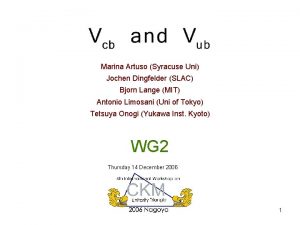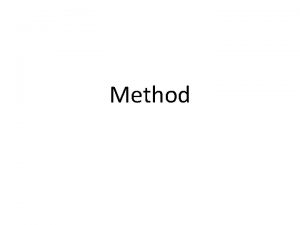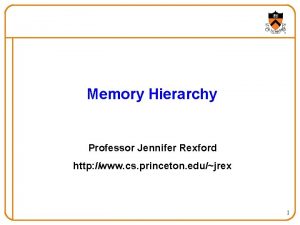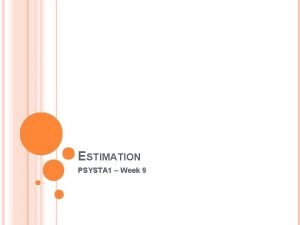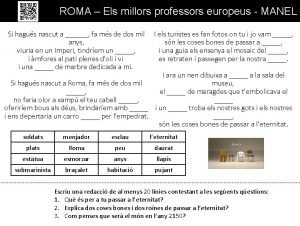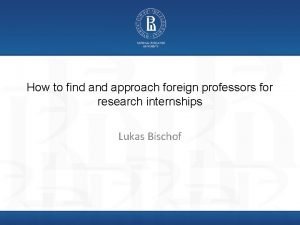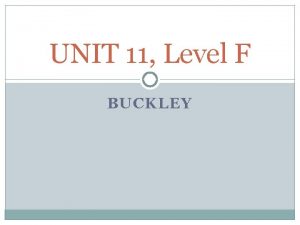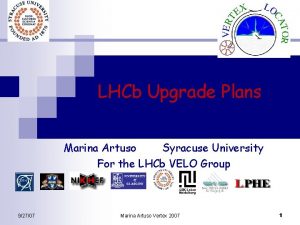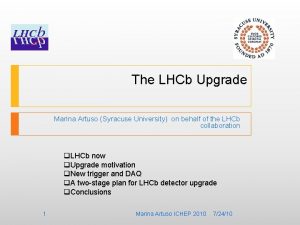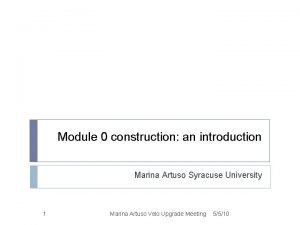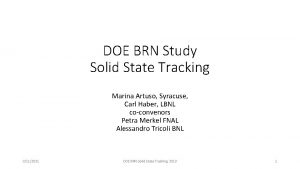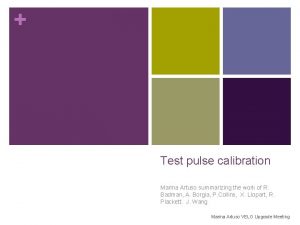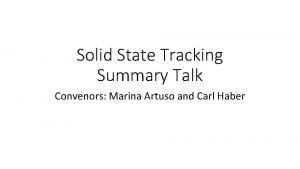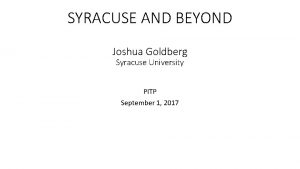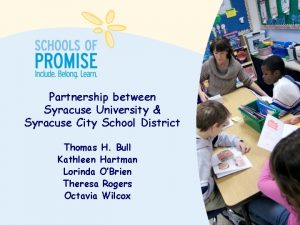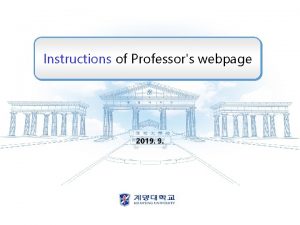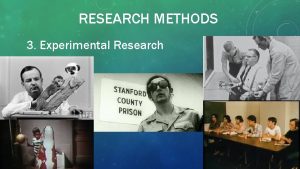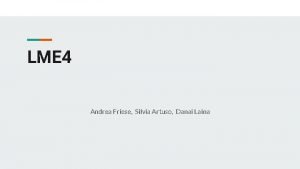Experimental HEP at Syracuse Marina Artuso Research Professors













- Slides: 13

Experimental HEP at Syracuse Marina Artuso Research Professors Steven Blusk Postdoctoral Researchers Tomasz Skwarnicki Sheldon Stone Mitch Soderberg Graduate Students +Anna Phan (At CERN) 1

Faculty hosts Mitch Soderberg Welcome Steven Blusk Ray Mountain Undergraduates who will be of help with the labs Emily Kraus Erika Cowan Dylan Hsu Anna Fadeeva 2

What is Quarknet Program funded by NSF and DOE (~15 years) Primary aims are to provide for teachers: q a deeper understanding of particle physics q a deeper appreciation of the machinery of modern science q Build inquiry-based learning environment … researchers build knowledge through inquiry, discussion, collaboration Additional goal: q Integrate some ideas of particle physics into the classroom. This doesn’t necessarily mean “new topics” E. g. Conservation of momentum, energy … can use particle collisions 3

Quarknet Centers 54 Centers at Universities and Laboratories, including Syracuse University 4

The program – Year 1 • Two teachers for 8 -week program – Last year, Ranald Bleakley and Josh Buchman spent their summer at CERN – Goals were to: • Get a taste of what it is like being engaged at the world’s most energetic collider • Learn a bit about the LHCb experiment • Develop an event display to visualize interactions in LHCb (software-based project). – Lots to learn, and they did a great job! 5

Years 2 - ? • Year 2: Approximately 10 more teachers for 3 -week institute (that’s now!) • Years 3 – 5: One-week program at Syracuse. • Years > 5: Other possibilities, most likely focused on projects that would involve 1 -2 teachers + students. 6

Keep in mind • If you have any questions, please don’t hesitate to ask. • We’ll do our best to answer. • Learning is “inquiry-based”… • Do you best to work within your group to answer your questions as a team. • Then, we’ll discuss questions at the end of the day. 7

General schedule (most days) • • • 8: 00 – 8: 30: Light breakfast 8: 30 – 9: 30: Lecture presentation + Q&A 9: 45 – 11: 45 Work on experiments 11: 45 – 12: 45 Lunch 1: 00 – 3: 00 Work on experiments 3: 00 – 3: 30 Meeting, Q&A, teachers share ideas about how they might integrate what they’ve learned into the classroom. 8

Overview of presentations/topics • • • General Overview – Particle Physics & Cosmology Relativity Quantum Physics Accelerators and Detectors Standard Model overview Strong & EM forces Weak forces and decays High energy collisions as microscopes Top quark and Higgs Neutrinos Applications of Particle physics in the “real” world 9

Today • • • Introductory Presentation – S. Blusk Coffee break Presentation on Relativity – M. Soderberg Lunch Introduction to the Experiments – R. Mountain Breakout – Look over lab writeups, work on any assigned “HW” problems 10

Overview of Particle Physics • “Laws” or theories used to describe nature – Driven by observation (measurement) – Postdictive & (hopefully) predictive • Particle Physics – Aims to describe the most fundamental objects in nature and the force laws that govern their interactions. – Currently: Standard Model (SM) • 6 Quarks, 6 leptons, and force carriers (g, gluon, W±, Z) • Works very well, but certainly an effective theory – #1 Goal in Particle Physics: Expose & elucidate the most fundamental theory of matter…. and many reasons to believe the SM is not it ! – ‘New Physics’ is any observation that is not in accord with the SM. 11

The sub-standard model ! Many key questions unanswered by SM q q q q Why 3 generations? Hierarchy problem? Explanation/origin of masses? Unification ? How does gravity fit in? Matter dominance over antimatter ? … + more Many key question unanswered in Cosmology q q What is the dark matter in the Universe? What is the dark energy in the Universe? What caused inflation? . . . + more The Connection: Expected that whatever the “New Physics” is that addresses SM questions also provides a candidate particle that forms the Dark Matter in the Universe This “new particle” ought to be observable in accelerator-based experiments 12

The future of Particle Physics Primary mission is to uncover and elucidate the New Physics that will help answer the fundamental shortcomings of the Standard Model - more complete theory of matter. Need to understand neutrinos, mass, oscillations. Also need to find the Higgs boson - Origin of mass in SM - Still on the loose! Direct Searches for New Particles (CMS & ATLAS) X Standard Model New Physics Precision measurements & rare decays (e. g B decays) B = SM + NP 13
 Hepbelle
Hepbelle Disadvantages of experimental research
Disadvantages of experimental research Research instrument in experimental research
Research instrument in experimental research Research instrument in experimental research
Research instrument in experimental research Experimental vs non experimental
Experimental vs non experimental What are the 5 types of non experimental research design
What are the 5 types of non experimental research design Experimental vs nonexperimental
Experimental vs nonexperimental Experimental vs non experimental
Experimental vs non experimental Hierarchy of professors
Hierarchy of professors Rizal visit to pakil and pagsanjan
Rizal visit to pakil and pagsanjan Average iq of university professors
Average iq of university professors Si hagues nascut a roma
Si hagues nascut a roma Foreign professors
Foreign professors Jack buckley syracuse
Jack buckley syracuse
